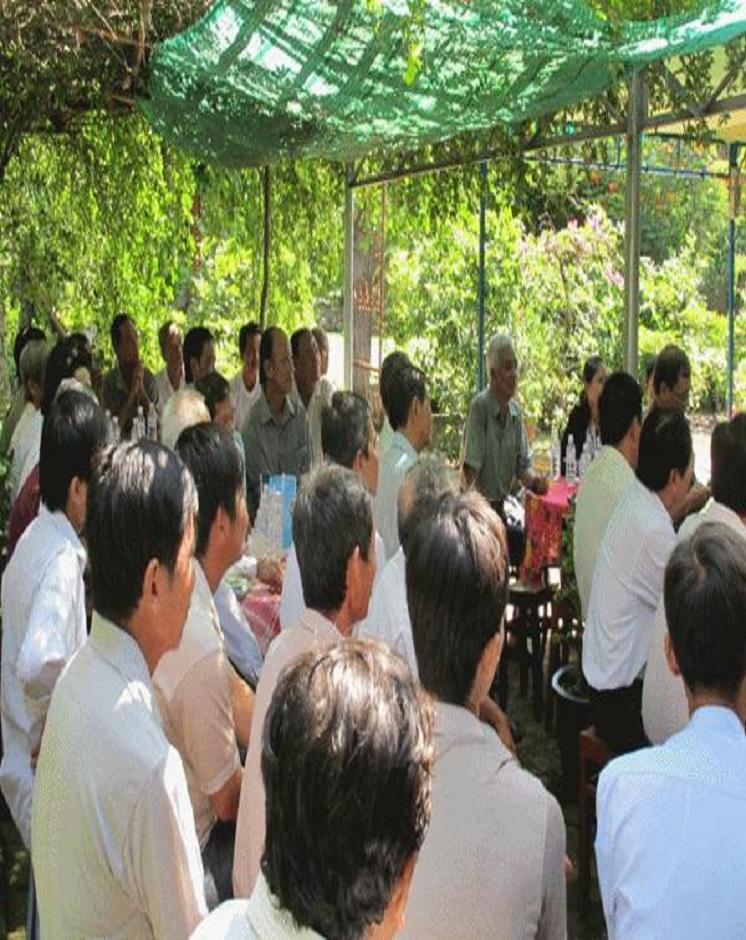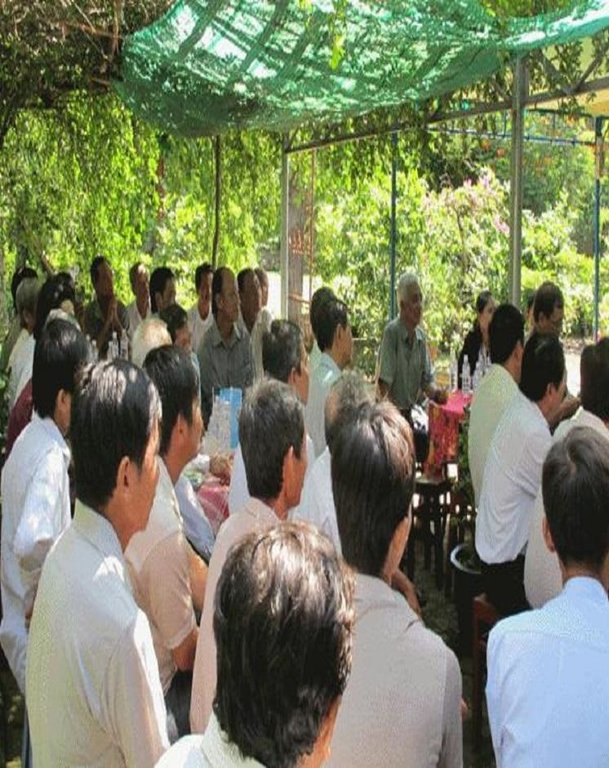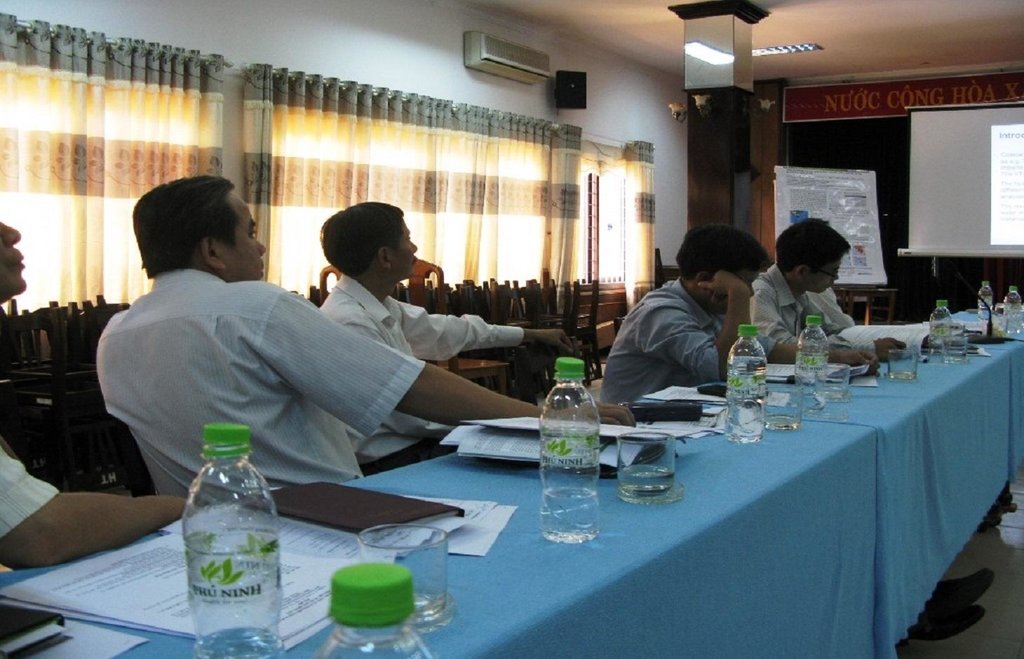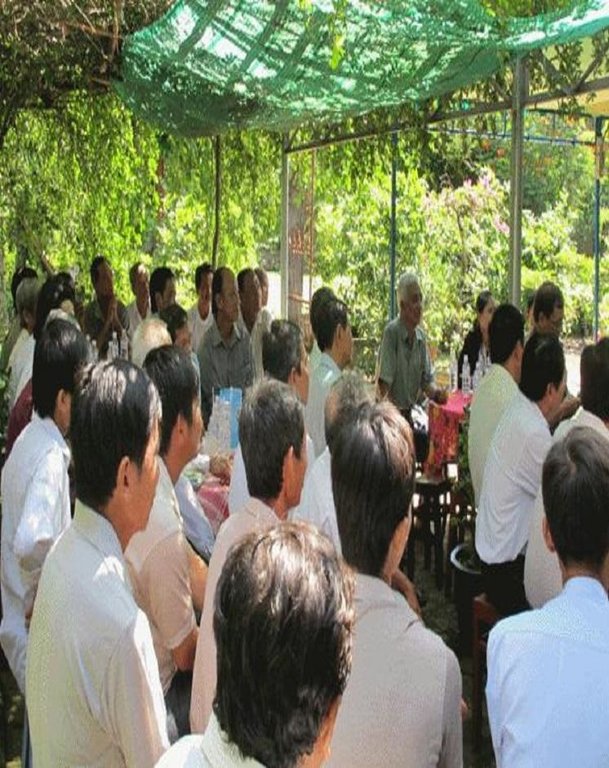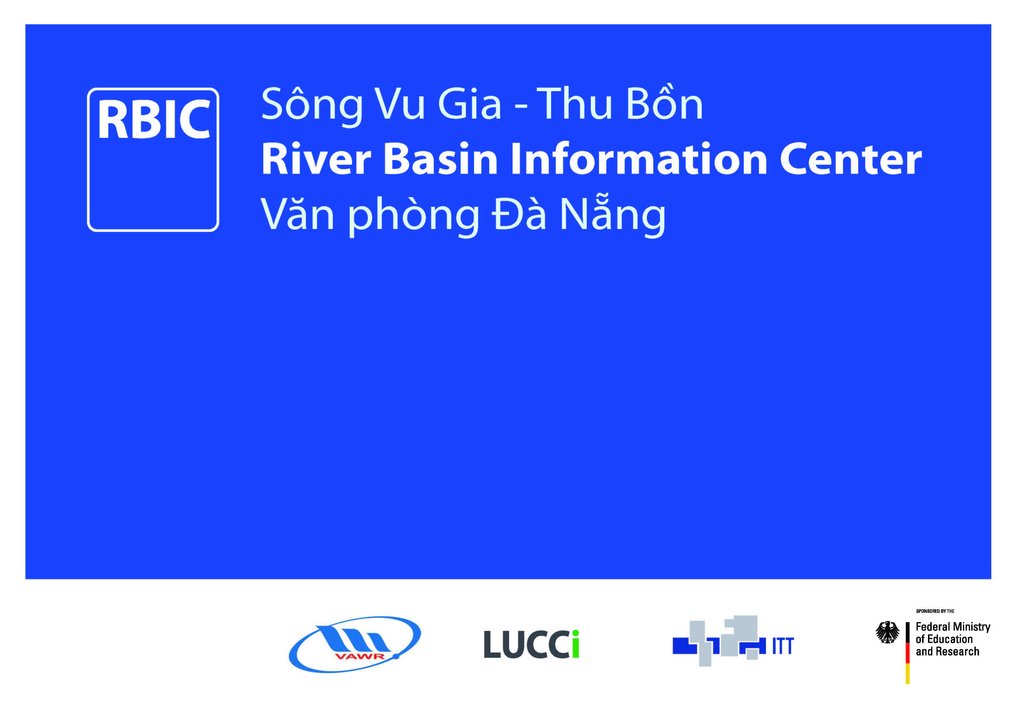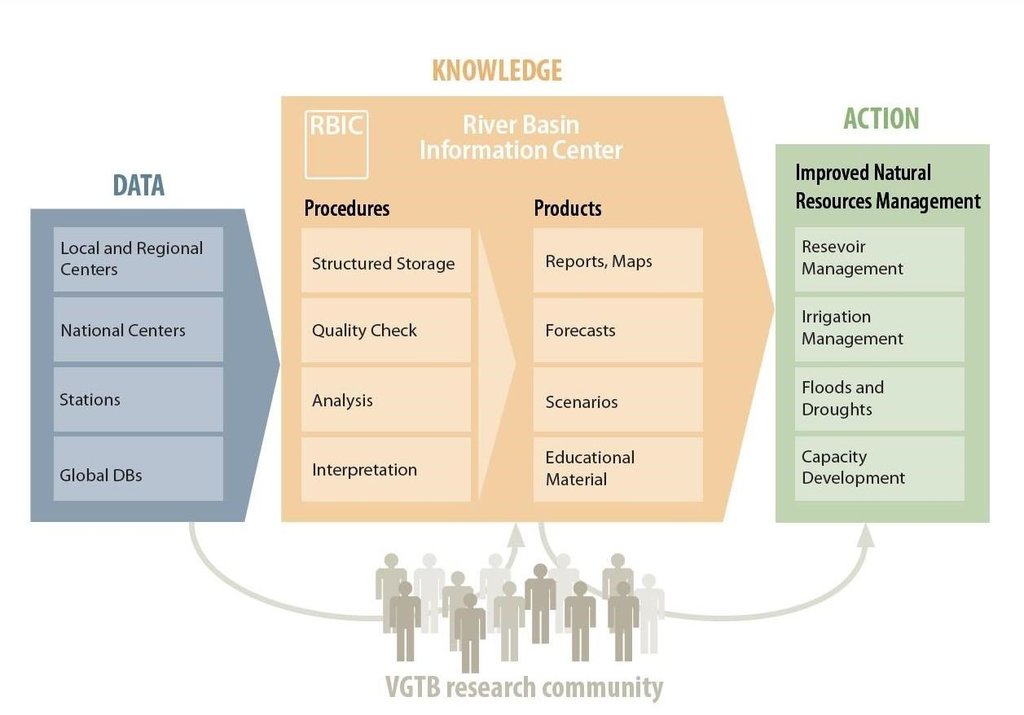Vu Gia Thu Bon River Basin Information Centre [越南]
- 创建:
- 更新:
- 编制者: Justyna Sycz
- 编辑者: –
- 审查者: Fabian Ottiger, Deborah Niggli
Trung tâm thông tin lưu vực sông VGTB (Vietnamese)
approaches_2536 - 越南
查看章节
全部展开 全部收起1. 一般信息
1.2 参与方法评估和文件编制的资源人员和机构的联系方式
SLM专业人员:
Nauditt Alexandra
alexandra.nauditt@th-koeln.de
University of Applied Science, TH Köln
德国
SLM专业人员:
Ribbe Lars
lars.ribbe@th-koeln.de
University of Applied Science, TH Köln
德国
SLM专业人员:
Nguyen Phong
phongicd@gmail.com
Vietnam Academy for Water Resources
Hanoi
越南
有助于对方法进行记录/评估的项目名称(如相关)
Book project: Making sense of research for sustainable land management (GLUES)有助于对方法进行记录/评估的机构名称(如相关)
University of Applied Science, TH Köln (TH Köln) - 德国有助于对方法进行记录/评估的机构名称(如相关)
Vietnam Academy for Water Resources (VAWR) - 越南1.3 关于使用通过WOCAT记录的数据的条件
(现场)数据是什么时候汇编的?:
27/07/2015
编制者和关键资源人员接受有关使用通过WOCAT记录数据的条件。:
是
1.4 SLM技术问卷的参考
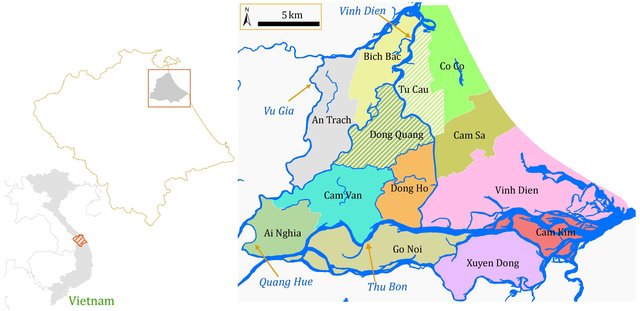
Water saving through reuse of return flow in … [越南]
Return flow from paddy fields is strategically collected before being lost to rivers and is reused as an effective source of agricultural water.
- 编制者: Justyna Sycz
2. SLM方法的描述
2.1 该方法的简要说明
The VGTB River Basin Information Centre (RBIC) offers decision support tools for stakeholders and aims at providing comprehensive information and consulting services to the water and land users according to their demands.
2.2 该方法的详细说明
该方法的详细说明:
Aims / objectives: Sufficient and sustainable water resource management at river basin scale can only be achieved if it is based on dialogue between all relevant stakeholders, and supported by adequate data. It follows then, that a robust system of monitoring, evaluation, reporting and communication is needed. The lack of appropriate management strategies which would bring these tools together has been underlined by stakeholders, and observed by researchers, involved in the research project LUCCi - Land Use and Climate Change Interactions in the VGTB River Basin. In order to offer a comprehensive decision-making support system, based on scientific knowledge and research results, the Institute for Technology and Resources Management (ITT, TH Köln, Germany) in cooperation with the Vietnam Academy for Water Resources (VAWR, Hanoi, Vietnam) established the VGTB River Basin Information Centre in Da Nang. The overall objective of RBIC is to support efficient and sustainable water and land use. The support provided for the implementation of the water saving technology for paddy systems is one of the services offered by the centre.
Methods: The VGTB RBIC is an independent, local institution administrated by the German and Vietnamese coordinators of LUCCi, financed by project sources and located at the Central Department of the Vietnam Academy of Water Resources in Da Nang. As a scientific organization, the VGTB RBIC provides the advantages of impartiality, a detailed knowledge base and a broad interdisciplinary perspective. Through different dissemination activities, such as visits to relevant institutions, information material (brochures, flyers in Vietnamese) as well as training courses and capacity building measures, the relevant stakeholders are well-informed about the activities of the Information Centre. On demand, the following products and services are provided in the VGTB-RBIC: (a) Thematic maps on land use, hydrology and river basin development; (b) A comprehensive database of the VGTB river basin (VGTB RBIS - River Basin Information System, open source) (c) VGTB State of the Basin Report as a decision-support instrument: the report was prepared by the LUCCi research team and provides relevant information on climatic, environmental and socioeconomic data and trends; (d) Hydro-meteorological, hydrograph and salinity data; (e) Flood and drought risk assessment; (f) Scenarios and modelling (reservoir operation, salinity intrusion, irrigation management scenarios); (g) Organization of meetings and discussions on key issues of the development of the VGTB; (f) Training and capacity building services related to the demands of stakeholders.
Role of stakeholders: Thus a heterogeneous stakeholder platform has been established in the case study region that includes scientific institutions, policy makers, public administration representatives as well as private sector companies. It is clear that the major problems of the VGTB River Basin can be only addressed, and adequate solutions identified, if based on active cross-sectoral stakeholder participation. Therefore, the interaction among stakeholders and RBIC plays a key role: the services are offered for the stakeholders, and stakeholder feedback is the basis for providing adequate information services and conducting applied based research.
2.3 该方法的照片
2.5 采用该方法的国家/地区/地点
国家:
越南
区域/州/省:
Da Nang
有关地点的进一步说明:
Central Vietnam
2.6 该方法的开始和终止日期
注明开始年份:
2013
终止年份(若不再采用该方法):
2015
2.7 方法的类型
- 基于项目/方案
2.8 该方法的主要目的/目标
The Approach focused mainly on other activities than SLM (Water management, agriculture, irrigation, water availability: support the local water users in the implementation of adequate water management strategies)
1. Establish a communication platform to discuss water and land use related problems, and create transparency among water users.
2. Support and foster the science-policy-society dialogue offering a cross-sectoral neutral space for discussion, consulting and capacity building for all stakeholders and water users (farmers, decision-makers, public institutions, private sector companies).
3. Provide a comprehensive information service and decision support system to stakeholders according to their demands. The following specific products and services are provided by the VGTB-RBIC: Thematic maps on land uses, hydrology and river basin development • Comprehensive database of the VGTB river basin (VGTB RBIS - River Basin Information System, open source) • VGTB State of the Basin Report as a decision support instrument: the report was prepared by the LUCCi research team and provides relevant information on climatic, environmental and socioeconomic data and trends • Hydro-meteorological, hydrograph and salinity data • Flood and drought risk assessment • Scenarios and modelling (reservoir operation, salinity intrusion, irrigation management scenarios) • Organization of meetings and discussions on key issues of the development of the VGTB • Training and capacity building services related to the demands of stakeholders.
The SLM Approach addressed the following problems: The lack of communication between the relevant institutions and water users, the demand for comprehensive decision-support instruments, difficulties with data availability - typically distributed and available at different institutions, as well as conflicts over resource use, were the main problems addressed by the approach. The conflicts caused by the rapid expansion of hydropower since 2008 in the VGTB river basin have especially demonstrated the inadequate participation of local stakeholders in planning processes. Hydropower development has adverse effects on downstream water availability, especially during the dry season, affecting drinking water supply and irrigation.
2.9 推动或妨碍实施本办法所适用的技术的条件
机构设置
- 阻碍
Lack of communication between the institutions and inadequate stakeholder involvement in the decision making process.
Treatment through the SLM Approach: VGTB RBIC offers a cross sectoral communication platform and bring together all relevant stakeholders: organization of workshops and meetings as well as visits to the relevant institutions.
了解SLM,获得技术支持
- 阻碍
A robust system of monitoring system was missed in the region: hydro-meteorological data, monitoring of water quantity.
Treatment through the SLM Approach: A monitoring network has been established as part of the LUCCi project.
其他
- 阻碍
Lack of information about the river basin in order to ensure an adequate decision making.
Treatment through the SLM Approach: A “State of the Basin Report” including all available data and information about the river basin has been elaborated (climatic, environmental, hydrological, land use and socioeconomic data and trends); River Basin Information System: Comprehensive data base of the VGTB river basin through the open source VGTB River Basin Information System.
3. 相关利益相关者的参与和角色
3.1 该方法涉及的利益相关者及其职责
- 研究人员
National and international researchers involved in the LUCCi project
- NGO
Authorities of a Water Management Unit (WMU)
- 国家政府(规划者、决策者)
Regional relevant institutions (DONRE, MARD, PPC Quang Nam)
- 国际组织
3.2 当地土地使用者/当地社区参与该方法的不同阶段
| 当地土地使用者/当地社区的参与 | 指定参与人员并描述活动 | |
|---|---|---|
| 启动/动机 | 被动 | Stakeholder analysis (including of all ineterested groups) |
| 计划 | 被动 | Local and regional decision makers are involved: workshops, discussions and surveys in order to collect relevant socio-economic and land use data, identify research demand and challenges |
| 实施 | 外部支持 | Land user decide on whether and which technologies they want to implement. |
| 监测/评估 | 无 | |
| Research | 互动 | Land users provide relevant information and data on their farms (size, yields) for research purposes. 'Aims/Objectives” elaborated and prepared for the stakeholders by Vietnamese and international researchers based on scientific results and data from land users. |
3.3 流程图(如可用)
具体说明:
The services of the VGTB Info-Centre are provided by a team of researchers and experts from national and international institutions. The services and products are offered to the following target groups: Public administration and decision-makers in Central Vietnam, Land and water users, researchers, and private sector companies in the field of water and land management (e.g. irrigation, hydropower construction)
Interaction and communication between the groups involved:
- based on stakeholders and target groups’ feedback, the centre can provide services suited to the needs of the regional institutions, considering current socioeconomic development and environmental changes in the river basin
- the centre provides a communication platform for the target groups involved from different sectors: private companies, public administration, researchers, land and water users.
3.4 有关SLM技术选择的决策
具体说明谁有权决定选择要实施的技术:
- 主要是SLM专家,咨询土地使用者之后
解释:
Decisions on the method of implementing the SLM Technology were made by mainly by SLM specialists with consultation of land users
4. 技术支持、能力建设和知识管理
4.1 能力建设/培训
是否为土地使用者/其他利益相关者提供培训?:
是
- decision makers/ experts/ local scientists
培训形式:
- 示范区域
涵盖的主题:
key aspects of an integrated river basin management (monitoring, data management and hydrological modelling); current situation, development and challenges in the VGTB river basin; training on adequate tools and technologies (alternative irrigation strategies for paddy fields: reuse of return flow)
4.2 咨询服务
土地使用者有权使用咨询服务吗?:
是
指明是否提供了咨询服务:
- 在固定中心
说明/注释:
Name of method used for advisory service: River Basin Information Center - RBIC; Key elements: Stakeholder Workshops, Trainings on alternative irrigation strategies for paddy fields: reuse of return flow
Advisory service is very adequate to ensure the continuation of land conservation activities; Researchers (VAWR): can offer trainings and conduct dissemination activities; Local institutions (e.g. People's Committee of Quang Nam Province): training, dissemination activities, financial support
4.3 机构强化(组织发展)
是否通过这种方法建立或加强了机构?:
- 是,非常
具体说明机构的强化或建立程度:
- 本地
具体说明支持类型:
- 能力建设/培训
- research
提供进一步细节:
Training for decision makers and professionals; Research: hydrological modeling
4.4 监测和评估
监测和评估是该方法的一部分吗?:
是
注释:
management of Approach aspects were ad hoc monitored by project staff through observations
management of Approach aspects were ad hoc monitored by project staff through measurements
There were several changes in the Approach as a result of monitoring and evaluation: The approach was based on the stakeholder-research interactions. The approach objectives and methodology was adapted to the local conditions and challenges.
There were no changes in the Technology as a result of monitoring and evaluation
4.5 研究
研究是该方法的一部分吗?
是
明确话题:
- 社会学
- 技术
- hydrological modeling
提供进一步的细节,并指出是谁做的研究:
The implementation of return flow from paddy fields as alternative irrigation technology under local conditions was performed under the framework of LUCCi project (ITT).
Research was carried out both on station and on-farm
5. 融资和外部物质支持
5.1 该方法中SLM组成部分的年度预算
如果不知道准确的年度预算,请给出一个范围:
- < 2,000
注释(例如主要的资助来源/主要捐助者):
Approach costs were met by the following donors: international (International (German Federal Ministry of Education and Research, BMBF)): 70.0%; government (National (Vietnam Academy for Water Resources, VAWR) ): 30.0%
5.4 信用
是否根据SLM活动的方法给予信用值?:
否
6. 影响分析和结论性陈述
6.1 方法的影响
该方法是否帮助土地使用者实施和维护SLM技术?:
- 否
- 是,很少
- 是,中等
- 是,支持力度很大
Decreased water use;efficient resource management
该方法是否有助于社会和经济弱势群体?:
- 否
- 是,很少
- 是,中等
- 是,支持力度很大
Did other land users / projects adopt the Approach?
- 否
- 是,很少
- 是,中等
- 是,支持力度很大
Did the Approach lead to improved livelihoods / human well-being?
- 否
- 是,很少
- 是,中等
- 是,支持力度很大
6.2 土地使用者实施SLM的主要动机
- 增加生产
- well-being and livelihoods improvement
Increase water use efficiency
6.3 方法活动的可持续性
土地使用者能否维持通过该方法实施的措施(无外部支持的情况下)?:
- 是
6.4 该方法的长处/优点
| 编制者或其他关键资源人员认为的长处/优势/机会 |
|---|
| The approach is managed by researchers. This has the advantages of impartiality, a detailed knowledge base and a broad interdisciplinary perspective. |
| Adaptability to stakeholders needs. (How to sustain/ enhance this strength: Strong interaction between the management of the VGTB RBIC and regional stakeholders is necessary: organize regular meetings and workshops; Stakeholders regularly inform the centre about their information requirements.) |
|
Monitoring, evaluation, reporting and communication are integrated, summarized and carried out by one institution. |
6.5 该方法的弱点/缺点以及克服它们的方法
| 土地使用者认为的弱点/缺点/风险 | 如何克服它们? |
|---|---|
| It needs long-term commitment from research, from extension, and from the government to support such a service for the benefit of all people and the environment. |
| 编制者或其他关键资源人员认为的弱点/缺点/风险 | 如何克服它们? |
|---|---|
|
The VGTB RBIC is a new institution, unknown to the local stakeholders. |
Provide dissemination activities and trainings in order to explain the decision making process and the role of VGTB RBIC as support instrument. |
|
The approach was developed as part of a research project. There is the risk, that the scale of activities and services will be reduced after the end of the project duration. |
Try to obtain financial resources by the local and public institutions in order to develop and manage the center after the end of the project. |
7. 参考和链接
7.1 方法/信息来源
- 实地考察、实地调查
- 与土地使用者的访谈
7.2 参考可用出版物
标题、作者、年份、ISBN:
Ribbe, L., Viet, Quoc Trinh, ABM Firoz, Anh Thu Nguyen, Uyen Nguyen, Alexandra Nauditt (2016) Integrated River Basin Management in the Vu Gia Thu Bon Basin
可以从哪里获得?成本如何?
Nauditt, Ribbe (editors) Land Use and Climate Change Interaction in Central Vietnam, Springer Book Series Water Resources Management and Development
链接和模块
全部展开 全部收起链接

Water saving through reuse of return flow in … [越南]
Return flow from paddy fields is strategically collected before being lost to rivers and is reused as an effective source of agricultural water.
- 编制者: Justyna Sycz
模块
无模块


